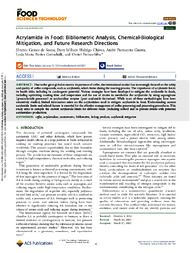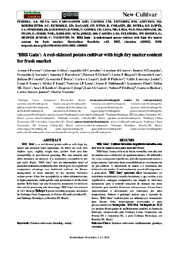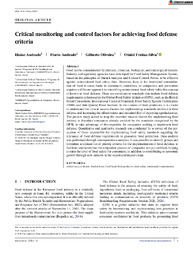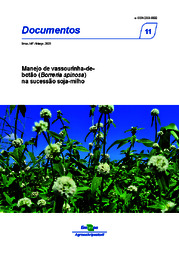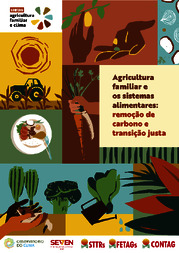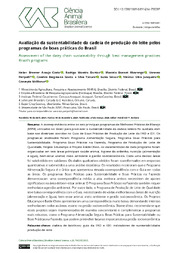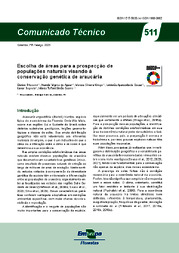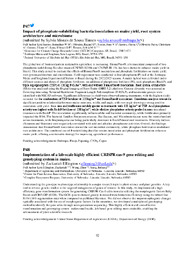Physiological potential of soybean industrially treated with different spray volumes and dry powder.
Filter by:
| Author(s): SOUZA, J. G. de; CHÁVEZ, D. W. H.; GUERRA, A. F.; GOTTSCHALK, L. M. F.; FREITAS-SILVA, O. Due to the great global economic importance of coffee, the international market has increasingly focused on the safety and quality of coffee compounds, such as acrylamide, which forms during the roast... ... |
| Author(s): PAULETTO, D.; ARCO-VERDE, M. F.; SILVA, I. C.; LOPES, L. S. de S.; ARAÚJO, A. J. C.; LUCAS, F. C. A.; SANTOS, S. F. dos; VIEIRA, T. A.; DIAS, C. T. dos S.; MARTORANO, L. G. Agroforestry systems (AFSs) exhibit varied composition and dynamics as intrinsic characteristics of their specificities. In this context, a review of the adoption, composition, and dynamics of AFSs in... ... |
| Author(s): PEREIRA, A. da S.; SILVA, G. O. da; CARVALHO, A. D. F. de; CASTRO, C. M.; EMYGDIO, B. M.; AZEVEDO, F. Q.; BORTOLETTO, A. C.; EICHOLZ, E. D.; RAGASSI, C. F.; UENO, B.; CORADIN, J. H.; DUTRA, L. F.; LOPES, C. A.; PINHEIRO, J. B.; LOURENÇO JUNIOR, V.; GOMES, C. B.; LIMA, M. F.; PINHEIRO, N. L.; MALDONADE, I. R.; PILON, L.; PILON, L.; FERRI, N. M. L.; KROLOW, A. C. R.; JORGE, R. O.; CASTRO, L. A. S. de; FELDBERG, N. P.; HEIDEN, G.; REISSER JUNIOR, C.; VIZZOTTO, M. ‘BRS Gaia’ is a red-skinned potato cultivar with high dry matter and attractive tuber appearance. Its tubers are oval, with shallow eyes, slightly rough skin, yellow flesh and low susceptibility to po... ... |
| Author(s): OLIVEIRA, C. A. G. de; MONTEIRO, E. de C.; SOUZA, W. DOS S.; PIO, P. V. A.; MACHADO, J. C.; ALVES, B. J. R.; BODDEY, R. M.; URQUIAGA, S. Elephant grass has high biomass production potential and can benefit from biological nitrogen fixation (BNF) as its main external nitrogen source. This study evaluated the effect of BNF on biomass pro... ... |
| Author(s): ANDRADE, E.; ANDRADE, F.; OLIVEIRA, G.; FREITAS-SILVA, O. Food can be contaminated by physical, chemical, biological, and radiological hazards. Industry and regulatory agencies have developed the Food Safety Management System, based on the principles of Haza... ... |
| Author(s): IKEDA, F. S.; OLIBONE, A. P. E.; GUIMARÃES, A. C. D.; SILVA, L. C. da Resumo: A vassourinha-de-botão vem se tornando um sério problema em propriedades agrícolas do estado de Mato Grosso, na região conhecida como Matopiba (Maranhão, Tocantins, Piauí e Bahia) (Minozzi, 20... ... |
| Author(s): LIMA, C. E. P.; RUBINSTEIN, F. B. P. L.; AMARAL, J. de B.; LEAL, L. S.; ZOCHE, R.; BONETTI, S. P. A livro discute os desafios e oportunidades da agricultura familiar no contexto da crise climática global. A publicação destaca o papel estratégico dos agricultores familiares na mitigação das mudança... ... |
| Author(s): COSTA, H; DANTAS, R. M.; ALVARENGA, M. B.; PERIPOLLI, V.; TANURE, C. B. G. e S.; SEIXAS, L.; JUNQUEIRA, V. S.; MCMANUS, C. A correspondência entre os seis principais programas de Melhores Práticas de Manejo (MPM) utilizados no Brasil para promover a sustentabilidade da cadeia leiteira foi avaliada com base nas diretrizes... ... |
| Author(s): FRITZSONS, E.; AGUIAR, A. V. de; WREGE, M. S.; SOUSA, V. A. de; BOGNOLA, I. A.; SOARES, M. T. S. Araucaria angustifolia (Bertol.) Kuntze, espécie típica do ecossistema da Floresta Ombrófila Mista, ocorre nas regiões Sul e Sudeste do Brasil, sobre distintos substratos geológicos, feições geomorfol... ... |
| Author(s): SANTOS, J. W. M.; OLIVEIRA, R. G.; AVELAR, J. S.; SANTOS, F. C. dos; OLIVEIRA-PAIVA, C. A.; GOMES, E. A.; LANA, U. G. de P.; SOUSA, S. M. de This study aimed to evaluate the effects of BiomaPhos® inoculation and phosphate fertilization on maize yield, root system architecture and microbiome. Field experiment was conducted in low-phosphorus... ... |
Observation
Some of Embrapa's publications are published as ePub files. To read them, use or download one of the following free software options to your computer or mobile device. Android: Google Play Books; IOS: iBooks; Windows and Linux: Calibre.
Access other publications
Access the Agricultural Research Database (BDPA) to consult Embrapa's full library collection and records.
Visit Embrapa Bookstore to purchase books and other publications sold by Embrapa.

